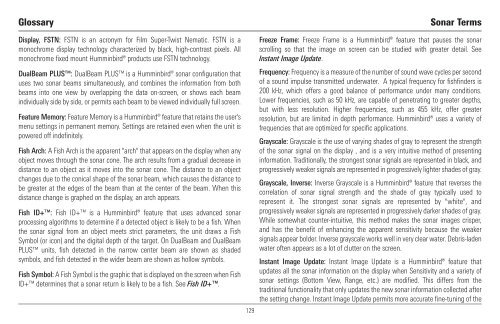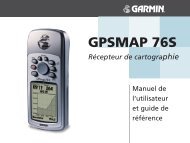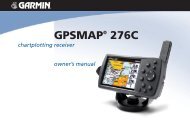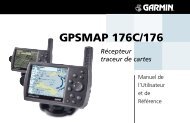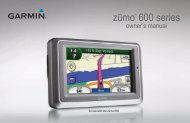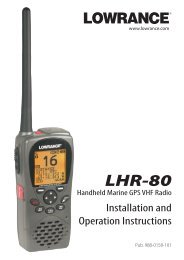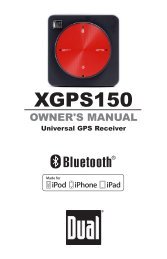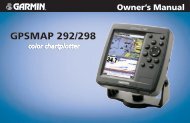Humminbird - Fish Finders and GPS
Humminbird - Fish Finders and GPS
Humminbird - Fish Finders and GPS
Create successful ePaper yourself
Turn your PDF publications into a flip-book with our unique Google optimized e-Paper software.
Glossary<br />
Display, FSTN: FSTN is an acronym for Film Super-Twist Nematic. FSTN is a<br />
monochrome display technology characterized by black, high-contrast pixels. All<br />
monochrome fixed mount <strong>Humminbird</strong>® products use FSTN technology.<br />
DualBeam PLUS: DualBeam PLUS is a <strong>Humminbird</strong>® sonar configuration that<br />
uses two sonar beams simultaneously, <strong>and</strong> combines the information from both<br />
beams into one view by overlapping the data on-screen, or shows each beam<br />
individually side by side, or permits each beam to be viewed individually full screen.<br />
Feature Memory: Feature Memory is a <strong>Humminbird</strong>® feature that retains the user's<br />
menu settings in permanent memory. Settings are retained even when the unit is<br />
powered off indefinitely.<br />
<strong>Fish</strong> Arch: A <strong>Fish</strong> Arch is the apparent "arch" that appears on the display when any<br />
object moves through the sonar cone. The arch results from a gradual decrease in<br />
distance to an object as it moves into the sonar cone. The distance to an object<br />
changes due to the conical shape of the sonar beam, which causes the distance to<br />
be greater at the edges of the beam than at the center of the beam. When this<br />
distance change is graphed on the display, an arch appears.<br />
<strong>Fish</strong> ID+: <strong>Fish</strong> ID+ is a <strong>Humminbird</strong>® feature that uses advanced sonar<br />
processing algorithms to determine if a detected object is likely to be a fish. When<br />
the sonar signal from an object meets strict parameters, the unit draws a <strong>Fish</strong><br />
Symbol (or icon) <strong>and</strong> the digital depth of the target. On DualBeam <strong>and</strong> DualBeam<br />
PLUS units, fish detected in the narrow center beam are shown as shaded<br />
symbols, <strong>and</strong> fish detected in the wider beam are shown as hollow symbols.<br />
<strong>Fish</strong> Symbol: A <strong>Fish</strong> Symbol is the graphic that is displayed on the screen when <strong>Fish</strong><br />
ID+ determines that a sonar return is likely to be a fish. See <strong>Fish</strong> ID+.<br />
129<br />
Sonar Terms<br />
Freeze Frame: Freeze Frame is a <strong>Humminbird</strong>® feature that pauses the sonar<br />
scrolling so that the image on screen can be studied with greater detail. See<br />
Instant Image Update.<br />
Frequency: Frequency is a measure of the number of sound wave cycles per second<br />
of a sound impulse transmitted underwater. A typical frequency for fishfinders is<br />
200 kHz, which offers a good balance of performance under many conditions.<br />
Lower frequencies, such as 50 kHz, are capable of penetrating to greater depths,<br />
but with less resolution. Higher frequencies, such as 455 kHz, offer greater<br />
resolution, but are limited in depth performance. <strong>Humminbird</strong>® uses a variety of<br />
frequencies that are optimized for specific applications.<br />
Grayscale: Grayscale is the use of varying shades of gray to represent the strength<br />
of the sonar signal on the display , <strong>and</strong> is a very intuitive method of presenting<br />
information. Traditionally, the strongest sonar signals are represented in black, <strong>and</strong><br />
progressively weaker signals are represented in progressively lighter shades of gray.<br />
Grayscale, Inverse: Inverse Grayscale is a <strong>Humminbird</strong>® feature that reverses the<br />
correlation of sonar signal strength <strong>and</strong> the shade of gray typically used to<br />
represent it. The strongest sonar signals are represented by "white", <strong>and</strong><br />
progressively weaker signals are represented in progressively darker shades of gray.<br />
While somewhat counter-intuitive, this method makes the sonar images crisper,<br />
<strong>and</strong> has the benefit of enhancing the apparent sensitivity because the weaker<br />
signals appear bolder. Inverse grayscale works well in very clear water. Debris-laden<br />
water often appears as a lot of clutter on the screen.<br />
Instant Image Update: Instant Image Update is a <strong>Humminbird</strong>® feature that<br />
updates all the sonar information on the display when Sensitivity <strong>and</strong> a variety of<br />
sonar settings (Bottom View, Range, etc.) are modified. This differs from the<br />
traditional functionality that only updates the new sonar information collected after<br />
the setting change. Instant Image Update permits more accurate fine-tuning of the


